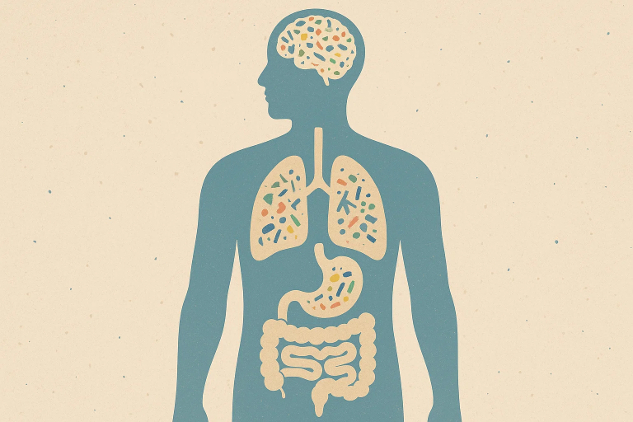
In This Article
- What are microplastics and where do they come from?
- How do microplastics affect your health?
- How do they get into your food, water, and air?
- What lifestyle changes can reduce your exposure?
- Can we really make a difference by avoiding plastics?
Microplastics Are Poisoning Us: 21 Ways to Fight Back
by Robert Jennings, InnerSelf.comBetween the allure of 'better living through chemistry' and the convenience of plastic-wrapped bananas, we've overlooked a crucial question: is this stuff safe? The answer is a resounding no. Microplastics, those minuscule fragments under five millimeters, have infiltrated our world to such an extent that they’ve become the glitter of the Anthropocene. They're in our bodies, from our lungs to our livers, even in the breast milk we feed our babies and the placentas of unborn children. This isn’t just a warning sign, it's a red flag for a systemic collapse.
Researchers are now connecting the dots: decreased sperm counts, disrupted hormones, chronic inflammation, digestive issues, lung irritation, and maybe even dementia. All thanks to the remarkable durability of plastic and our relentless pursuit of convenience.
From Tires to Takeout: The Plastic Highway into Your Body
You don’t need to chew on a plastic spoon to get a mouthful of microplastics. These little invaders travel like seasoned hitchhikers: released from car tires into city air, shed from synthetic clothes into your laundry water, leached from plastic containers into your leftovers. The average person ingests tens of thousands of plastic particles a year—and that’s a conservative estimate.
Ever notice how your food tastes faintly like plastic wrap? That’s not just your imagination. Ultra-processed foods, packaged meals, and fast food are more likely to be contaminated, likely due to the extensive use of plastic in their manufacturing, shipping, and storage. Meanwhile, microwaving your leftovers in a plastic container? That’s like simmering your food in a teabag made of poison. Millions of microplastics per serving. Bon appétit.
Health Impacts: Silent and Systemic
The science is still catching up, but what we do know should be enough to jolt even the most plastic-addicted among us. Chronic inflammation triggered by microplastics could lead to colon and lung cancer. Nanoplastics—yes, they get even smaller—can cross the blood-brain barrier. Think about that the next time you sip bottled water sold as "pure." Researchers suspect cardiovascular disease and even dementia may be part of the long-term price we’re paying for our dependence on plastic.
Let’s be clear: this isn’t a fringe conspiracy theory, it’s mainstream environmental health science. It's the kind of science that should be sparking urgent action from governments. Instead, we're bombarded with greenwashing, biodegradable buzzwords, and more plastic-wrapped 'eco-friendly' products. It's a theater of the absurd, where we try to solve a plastic crisis by creating more plastic, albeit with a leaf logo. It's time for systemic change, and we all have a role to play in making it happen.
Simple (but Not Easy) Steps to Avoid Microplastics
It’s not about going off-grid and crafting your own clay jars under the moonlight. It's about making meaningful changes within the constraints of your daily life. Here’s a practical, science-backed list of actions that can significantly reduce your exposure to microplastics. It's not about turning your life upside down, it's about taking control and making a difference.
-
Drink filtered tap water, not bottled water. Bottled water contains, on average, more than 100 times the amount of microplastics found in tap water. Use a high-quality water filter (like reverse osmosis or activated carbon) to reduce microplastics and chemical contaminants.
-
Use glass, stainless steel, or ceramic containers for food storage. Avoid plastic Tupperware and food wrap, especially with hot or acidic foods. Plastics degrade over time, leaching particles into what you eat.
-
Never microwave food in plastic containers. Heat accelerates the release of microplastics and plasticizers. Transfer leftovers to a glass or ceramic dish before reheating.
-
Avoid using single-use plastics whenever possible. That includes plastic water bottles, disposable cutlery, and takeout containers. Bring your own reusable options instead.
-
Minimize packaged and ultra-processed foods. These often contain more plastic contamination, likely due to extensive contact with plastic during processing and packaging.
-
Clean your home with a HEPA vacuum and wet dusting techniques. Microplastics settle in household dust. Using a vacuum with a HEPA filter and damp microfiber cloths will help capture them rather than recirculating them.
-
Wash synthetic clothes less frequently—and with care. Clothes made from polyester, nylon, and acrylic shed plastic microfibers during the laundry process. Use a microfiber-catching filter (like a Guppyfriend bag or washing machine filter) and wash only when necessary, in cold water, with full loads.
-
Install a washing machine filter for microfibers. External filters, such as the Lint LUV-R, or internal models can trap thousands of plastic fibers before they enter the wastewater stream—or your water supply.
-
Opt for natural fabrics like cotton, wool, and linen. Synthetic fabrics are major contributors to microplastic pollution. Choose organic or minimally treated natural fibers when possible.
-
Switch to solid bars instead of liquid soaps and shampoos in plastic bottles. Many liquids come in plastic containers or contain plastic thickeners. Bar versions reduce both chemical additives and packaging.
-
Avoid personal care products with microbeads or hidden plastics. Scrubs, exfoliants, and even some toothpastes include polyethylene or polypropylene. Read labels and choose products that are microbead-free and fragrance-free.
-
Cook with stainless steel, cast iron, or ceramic cookware. Avoid nonstick cookware, especially older Teflon-style pans that can degrade and release microplastics and PFAS (“forever chemicals”).
-
Use natural cleaning tools and materials. Plastic sponges, brushes, and cloths can shed fibers. Opt for natural cellulose sponges, coconut-bristle brushes, and cotton cloths.
-
Avoid chewing on or drinking through plastic straws. Replace them with stainless steel, glass, or paper straws. The friction from teeth can release microplastic fragments directly into your mouth.
-
Store pantry foods in glass jars, not plastic bags. Rice, pasta, nuts, and grains can be purchased in bulk and stored in reused glass containers instead of plastic packaging.
-
Rethink your baby gear and toys. Babies often chew on everything, and many toys, bottles, and utensils are made of soft plastics that are prone to leaching. Use wood, silicone, or stainless steel alternatives when possible.
-
Choose powdered detergents over pods. Many detergent pods are wrapped in PVA (polyvinyl alcohol), which doesn’t always biodegrade and may release microplastics into wastewater systems.
-
Avoid synthetic tea bags. Some “silky” or pyramid-style tea bags are made of nylon or PET, and steeping them in hot water releases billions of nanoplastics. Stick to loose-leaf tea or paper tea bags labeled plastic-free.
-
Limit consumption of large seafood species and farmed fish. Top predators, such as tuna, accumulate more plastic over time. Smaller wild-caught fish generally contain fewer pollutants and less plastic.
-
Support plastic-free and refill businesses. Many health food stores now offer refill stations for soap, shampoo, and pantry staples. Supporting these businesses helps shift the market away from its dependency on plastic.
-
Pressure local officials and vote for environmental policy change. This isn’t just a personal problem. The root cause is systemic. Petition for bans on single-use plastics, better water filtration infrastructure, and manufacturer accountability.
No, you won’t eliminate microplastics completely—not unless you invent a time machine and stop the plastics industry in the 1940s. But every reduction counts. Less plastic in your food, your water, your home—that’s less inflammation, less cancer risk, and a little more control in an otherwise poisoned landscape. Small habits compound. And you’re not just protecting yourself—you’re challenging the system that put this poison in your path in the first place.
Eat Down the Food Chain
Bigger animals have more contaminants. The higher up the food chain you go, the more plastic and pollutants accumulate. Fish aren’t just swimming in plastic—they’re eating it, and you’re eating them. Smaller fish, such as sardines and mackerel, tend to be safer than top predators, like tuna. And don’t get me started on red meat from animals fed on plastic-laced grain and housed in plastic-heavy environments.
A plant-based diet isn’t just good for the planet—it’s a practical strategy to cut your microplastics load. Whole grains, beans, fresh vegetables, and fruits are the most consistent low-plastic foods you can eat. That’s not ideology. That’s chemistry.
The Fossil Fuel Industry: Poisoning Us Twice
Let’s stop dancing around it: the fossil fuel industry isn’t just selling gas—they’re selling cancer, climate collapse, and plastic poisoning all rolled into one tidy quarterly dividend. You want to know where plastic comes from? Look no further than the oil rigs, refineries, and chemical plants owned by Big Oil, and friends. These aren't energy companies anymore. They’re petrochemical empires, and plastic is their latest cash cow.
As the world slowly transitions away from oil-powered cars and gas-fired power plants, the industry has found its new growth sector: plastic. The International Energy Agency estimates that nearly half of the future demand for oil will come not from fueling your car, but from making plastic—bottles, bags, toys, packaging, pipes, and yes, the microplastics now found in your blood and brain.
First, they warm the planet. Then, when the pressure gets too hot—literally—they shift to making the very pollutants choking our oceans and infiltrating our lungs. It’s like watching a house burn while the arsonist sets up a lemonade stand outside to sell you a cool drink. You’re not just breathing their carbon. You’re eating their plastic.
Let’s call it what it is: it is becoming the most destructive industry in human history. They’ve destabilized the planet’s climate, driven extinction at a pace unseen in 65 million years, and now they’re quietly embedding their waste into every cell of our bodies. And somehow, they’re still welcomed at global climate summits. Still shaping policy. Still being subsidized with your tax dollars. And still bribing our politicians.
Microplastics aren't just a side effect—they’re a business model. A controlled demolition of public health, one sandwich bag at a time. And every time we vote for plastic deregulation, ignore greenwashing, or stay silent while lawmakers gut environmental protections, we’re handing the fossil fuel industry another match and another gallon of gasoline.
So yes, avoiding microplastics matters. But naming the enemy matters as well. Because this isn’t about personal purity—it’s about collective survival. And we won’t solve a systemic poisoning by pretending it’s just our fault for drinking out of the wrong cup. The system is rigged. And the rig is owned by Big Oil.
Systemic Problems Need Systemic Solutions
You can’t detox your way out of a toxic system. Sure, avoiding plastic will reduce your personal exposure, but the production machine continues to roll on. Fossil fuel companies are doubling down on plastic as the future cash cow. Recycling? Mostly a myth. Less than 10% of plastic ever made has been recycled. The rest? It's either burned, buried, or breaking into dust inside your lungs.
That’s why individual action, while necessary, isn’t sufficient. We need regulation. We need bans. We need to redefine what convenience costs—because the real price is human health. Your kid’s immune system isn’t a fair trade for an indestructible yogurt cup. We need to raise hell, vote like it matters, and stop letting corporations pass off the mess they made as your responsibility to clean up.
This isn’t about purity. It’s about survival. If we can wake up to the toxic mess we’ve normalized, maybe we can still fix it. But make no mistake—plastic is not progress. It’s pollution wrapped in marketing.
So stop microwaving plastic. Start asking questions. And if anyone calls you paranoid for bringing your own glass container to the farmer’s market, tell them it’s not paranoia if the poison is real.
About the Author
 Robert Jennings is the co-publisher of InnerSelf.com, a platform dedicated to empowering individuals and fostering a more connected, equitable world. A veteran of the U.S. Marine Corps and the U.S. Army, Robert draws on his diverse life experiences, from working in real estate and construction to building InnerSelf with his wife, Marie T. Russell, to bring a practical, grounded perspective to life’s challenges. Founded in 1996, InnerSelf.com shares insights to help people make informed, meaningful choices for themselves and the planet. More than 30 years later, InnerSelf continues to inspire clarity and empowerment.
Robert Jennings is the co-publisher of InnerSelf.com, a platform dedicated to empowering individuals and fostering a more connected, equitable world. A veteran of the U.S. Marine Corps and the U.S. Army, Robert draws on his diverse life experiences, from working in real estate and construction to building InnerSelf with his wife, Marie T. Russell, to bring a practical, grounded perspective to life’s challenges. Founded in 1996, InnerSelf.com shares insights to help people make informed, meaningful choices for themselves and the planet. More than 30 years later, InnerSelf continues to inspire clarity and empowerment.
Creative Commons 4.0
This article is licensed under a Creative Commons Attribution-Share Alike 4.0 License. Attribute the author Robert Jennings, InnerSelf.com. Link back to the article This article originally appeared on InnerSelf.com
books_health
Article Recap
Microplastics exposure is rising—and it's personal. These tiny pollutants infiltrate our food, water, homes, and even our bodies, leading to serious health risks. While we can’t eliminate all exposure, we can significantly reduce it. By learning how to avoid microplastics through simple shifts in diet, cleaning, and product choices, we reclaim some control—and push for systemic change in a plastic-soaked world.
#microplastics #plasticpollution #toxicplastics #healthrisks #cleaneating #environmentalhealth #plasticfree #greenliving #reduceplastic #everydaytoxins



